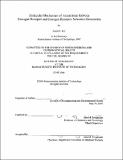| dc.contributor.advisor | John M. Essigmann. | en_US |
| dc.contributor.author | Lee, Annie S. (Annie Sang), 1975- | en_US |
| dc.contributor.other | Massachusetts Institute of Technology. Division of Bioengineering and Environmental Health. | en_US |
| dc.date.accessioned | 2012-09-27T15:23:55Z | |
| dc.date.available | 2012-09-27T15:23:55Z | |
| dc.date.copyright | 2000 | en_US |
| dc.date.issued | 2000 | en_US |
| dc.identifier.uri | http://hdl.handle.net/1721.1/73348 | |
| dc.description | Thesis (S.M.)--Massachusetts Institute of Technology, Division of Bioengineering and Environmental Health, 2000. | en_US |
| dc.description | Includes bibliographical references (leaves 43-47). | en_US |
| dc.description.abstract | Although one million new breast cancer cases arise each year worldwide, therapies to treat the disease are limited. Conventional treatments including the chemotherapeutic agent, Tamoxifen, have had only limited success, often showing uncomfortable side effects. Our group has proposed a new scheme for a rational drug design. This scheme utilizes recent findings on the mechanism of cisplatin, the drug found to cure in excess of 93% of all testicular cancer cases. Cisplatin forms DNA adducts that are toxic. The toxicity of these adducts is enhanced by the recruitment of proteins that bind to the adducts and impede adduct repair. This thesis was an attempt to duplicate this "repair shielding" mechanism with another cytotoxin. Specifically, this toxin will be programmed to kill breast cancer cells. Breast cancer cells often overexpress the estrogen receptor protein. By synthesizing a drug that not only binds and damages the DNA but also binds the abundant proteins in the cells, thereby blocking the damaged site from DNA repair proteins, a selective treatment of cancer cells can be achieved. In this study, the human estrogen receptor (hER) and the ligand binding domain of the hER genes were cloned into baculovirus expression vectors, establishing a system where a large quantity of the proteins can be expressed. The proteins expressed in insect cells were purified in one step, using the FLAG-epitope, yielding homogeneous proteins. The proteins were tested for binding to p-estradiol and were confirmed to be functional in ligand binding. They were also tested for their ability to bind the novel drugs synthesized to bind both the protein and the DNA. It was found that the ligand binding domain of the hER was capable of binding the drugs adducted to the DNA. In an effort to elucidate the mechanism of the protein-drug-DNA complex formation, an association experiment was carried out, which showed that the drug more readily bound to the protein than to DNA. However, a significant amount of the drug-protein complex still bound the DNA, if the ratio of the protein to the drug did not exceed 1.5. | en_US |
| dc.description.statementofresponsibility | by Annie S. Lee. | en_US |
| dc.format.extent | 69 leaves | en_US |
| dc.language.iso | eng | en_US |
| dc.publisher | Massachusetts Institute of Technology | en_US |
| dc.rights | MIT theses may be protected by copyright. Please reuse MIT thesis content according to the MIT Libraries Permissions Policy, which is available through the URL provided. | en_US |
| dc.rights.uri | http://dspace.mit.edu/handle/1721.1/7582 | en_US |
| dc.subject | Division of Bioengineering and Environmental Health. | en_US |
| dc.title | Molecular mechanism of interactions between estrogen receptor and estrogen receptor selective genotoxins | en_US |
| dc.type | Thesis | en_US |
| dc.description.degree | S.M. | en_US |
| dc.contributor.department | Massachusetts Institute of Technology. Division of Bioengineering and Environmental Health | en_US |
| dc.contributor.department | Massachusetts Institute of Technology. Department of Biological Engineering | |
| dc.identifier.oclc | 47862348 | en_US |
